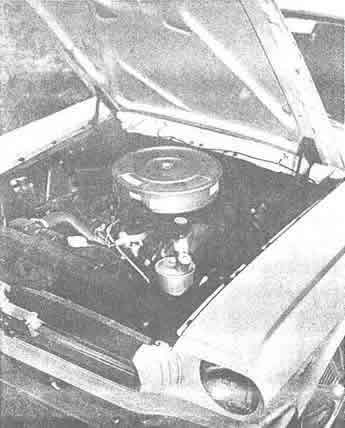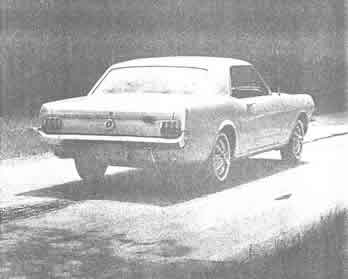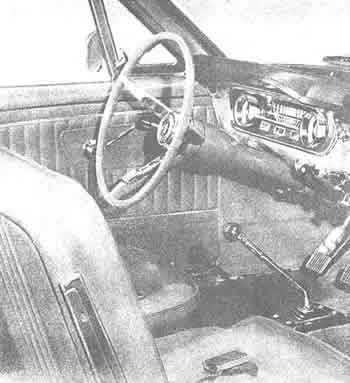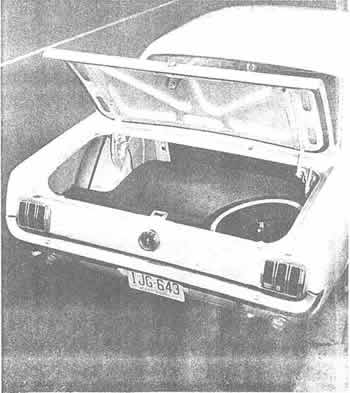 |
||||||
 |
||||||
 |
||||||
ROAD TEST:
Variety is one of the important characteristics of the Mustang, particularly since the choice of an engine in any automobile determines in large measure the basic-character of that car. With Mustang, for example, it is possible to get 427 throbbing and snorting cu. in. with overhead camshafts, provided your name is among the select few at the top of the dragstrip honors list. At the other extreme, an almost mincing and dainty demeanor results from placing an early 170-cu. in. Six in harness. In between these benchmarks, an amazing assortment of images may flash through any given Mustang driver's mind, depending upon the engine from the Ford collection he has selected to power his car.
 Most
engines are based on the 289-cu. in. thinwall block which first saw service
in the Fairlane as a basic, 221-cu. in. V-8. It grew to 260 cu. in, then to
289, and by the time Carroll Shelby proved that wondrous things could happen
with it, what the British call "stage tuning" had become an accepted
fact. In dropping the 260 block from the Ford inventory during the fall of 1964,
it was necessary to provide a replacement "regular fuel" V-8 to be
the basic, or standard, V-8 for the Mustang line - better than the Sixes, but
something less than Eights, which are referred to as "performance"
or "high performance." The niche was filled by a 289 engine with 2-barrel
carburetion and no British-type tuning to speak of.
Most
engines are based on the 289-cu. in. thinwall block which first saw service
in the Fairlane as a basic, 221-cu. in. V-8. It grew to 260 cu. in, then to
289, and by the time Carroll Shelby proved that wondrous things could happen
with it, what the British call "stage tuning" had become an accepted
fact. In dropping the 260 block from the Ford inventory during the fall of 1964,
it was necessary to provide a replacement "regular fuel" V-8 to be
the basic, or standard, V-8 for the Mustang line - better than the Sixes, but
something less than Eights, which are referred to as "performance"
or "high performance." The niche was filled by a 289 engine with 2-barrel
carburetion and no British-type tuning to speak of.
Prior to the 1965
model year, this engine was rated at 195 bhp at 4400 rpm and churned out 282
Ib.-ft. of torque at 2400 rpm. But in Ford's never-ending battle with Chevrolet
in the marketplace, these figures were almost identical to those published for
the better-selling arch-rival's 283-cu. in. engine, similarly set up. Consequently,
as 1965 models were announced Ford announced revised ratings for both this engine
and a 4-barrel version. Henceforth, the 289 with 2-barrel carburetor would be
200 bhp at 4400 rpm, still with 282 Ib.-ft. of torque. The 4-barrel-equipped
engine was rated at 225 bhp at 4800, up from 210 bhp at 4400, and had a revised
torque peak of 305 Ib.-ft. at 3200, up from 300 at 2800.
Among changes made to result in this were an increase in compression ratio from 8.7 to 9.2:1, slight freeing up of valve timing and an increase in valve sizes to 1.781 in. intakes and 1.450 in. exhausts, up from 1.670 and 1.389 in, respectively. As a result, the 200-bhp version in the test Mustang really suffered with West Coast regular fuel, even though the 9.2 compression was not too high for that grade in other parts of the country.
Aside from that, there is another drawback to this engine, Larger valves and freer valve timing have enhanced the engine's ability to breathe better, it is true, but the installation of a 2-barrel carburetor exacts its penalty. Another British term comes to mind in this connection - "dual choke." That is about what happens when a carburetor with only two barrels of 1.437 in. diameter regulates the amount of atmosphere which the churning pistons are permitted to pump. Just when the engine starts getting up a head of steam, it runs out of wind. Engine speed above 4500 rpm turns into a strained and asthmatic struggle which isn't worth the effort.
With a manual transmission like the Ford-built 4-speed, the engine can be forced to rev on up to 5000, but this is of little benefit. The final agonizing 500 rpm take's about as long to achieve as the first 4500 and acceleration suffers.
Similarly, when equipped with the 3-speed Cruise-0-Matic transmission, gear holding can be forced beyond the normal 4200 rpm w.o.t, shift points. But the skill required to outwit both the gearbox and the engine's affliction means that more consistent acceleration times are achieved by letting the transmission shift for itself. The average driver is best advised to merely floorboard the throttle and drive off down the dragstrip.
 Yet,
the buyer of a Mustang such as this isn't really likely to be driving on dragstrips,
unless he does initially out of curiosity. He is most apt to be driving on expressways
between suburbs and business office, a utilization for which this Mustang is
ideal. When not strained or abused, the "basic" V-8 performs most
adequately in normal service and provides a bonus from that very carburetion
constriction in the form of better fuel mileage. The Mustang, after all, represents
only 15 Ib. for each of the 200 horses, a ratio many standard cars are hard-pressed
to achieve.
Yet,
the buyer of a Mustang such as this isn't really likely to be driving on dragstrips,
unless he does initially out of curiosity. He is most apt to be driving on expressways
between suburbs and business office, a utilization for which this Mustang is
ideal. When not strained or abused, the "basic" V-8 performs most
adequately in normal service and provides a bonus from that very carburetion
constriction in the form of better fuel mileage. The Mustang, after all, represents
only 15 Ib. for each of the 200 horses, a ratio many standard cars are hard-pressed
to achieve.
Dad can feel pleased with himself because of the 4-speed he can use to extract optimum performance from the engine's limited rev range. Depending on rear axle selected, the engine can do as much-as an average owner is apt to demand from it. With the standard 3.00:1 gears and the 6.50-14 tires on the test car, it would cruise all day at a strain-free 24.7 mph for each 1000 rpm in high. Dropping down into third to negotiate a sharper-than-expected comer, or for some spirited passing, changes to a 1.36:1 ratio which, while not exactly ideal, is certainly adequate with the rear gears used.
The 4-speed supplied with the 289/200 does not come with the more ideal Ford gearset used in HP Mustang applications. That transmission had a 2.32:1 first, 1.69 second, and 1.29:1 third, all much better when really serious driving. is in order. Combined with the 3.89:1 rear axle, really spirited performance is in order - but that is another Mustang and another road test.
Clutch operation in the test car was light and positive. Of semi-centrifugal design, the 10.4 in. single plate clutch operated at 1269 Ib. pressure - more than adequate in view of the relatively limited torque generated against it.
Normal rate suspension components on the Mustang are really a mixed blessing. The car by its very concept encourages driving a bit harder than one otherwise would and standard spring rates and shock absorber valving are too much toward the light side to withstand much of that. Their compromise is in keeping with Detroit's practice of tailoring the riding qualities toward softness, which the American car-buying public has been conditioned to demand.
This car can be horsed around a great deal more than one would expect, provided its occupants are willing to suffer the consequent roller-coastering. Roadability and handling are on a high order once the body-lean barrier is crossed. It is pointless, of course, to abuse this car in such a manner, but it still is reassuring to know that the car would see you through a tight spot when necessary. An enthusiastic driver is going to order his car with heavy-duty suspension components anyway, regardless of some sacrifice in riding qualities (which may not be all that bad).
The basic Mustang design has its front roll center located slightly more than 2 in. above ground level, contrary to the predominant American practice of placing it at ground level or below. This means that the front wheels remain somewhat better placed in relation to the road surface, in effect, during jounce and rebound. The most noticeable improvement is at the outside front wheel during cornering, which tends to plant more tread rubber more firmly on the ground with the higher center location. The anti-roll bar keeps both front wheels in a manageable relationship to each other by countering the effect of weight shift during body lean.
 At
the rear, the roll center is located at 9.3 in. above ground, where it naturally
falls with the Hotchkiss-type live axle and leaf spring layout. The resultant
roll axis, combined with Mustang's frontward weight bias, contribute to the
basic understeering nature of the beast. Here again there has been engineering
compromise to suit American tastes, but there also has been the recognition
of enthusiast demands for better handling. When the Mustang is on the road,
understeering effect is at a minimum and the handling qualities approach neutral.
At
the rear, the roll center is located at 9.3 in. above ground, where it naturally
falls with the Hotchkiss-type live axle and leaf spring layout. The resultant
roll axis, combined with Mustang's frontward weight bias, contribute to the
basic understeering nature of the beast. Here again there has been engineering
compromise to suit American tastes, but there also has been the recognition
of enthusiast demands for better handling. When the Mustang is on the road,
understeering effect is at a minimum and the handling qualities approach neutral.
Oversteering while cornering can be induced with excess throttle, of course, even with the test Mustang's 200 bhp. This partially results from the lighter loading of the rear axle and, indeed, is most bothersome on rough road surfaces. There the lack of sufficient (in our view) shock damping and control is most glaring and in fact is the primary situation for criticism of the car's readability. Heavy-duty suspension components do a great deal to overcome such axle tramp, but some sort of traction bars would be even better. And again, soft spring rates per se do not cause the problem, they merely aggravate it.
The fact is, weight distribution is not vastly improved from domestic automotive practice, despite the visual appearance of having moved everything back behind a long hood. Rear wheels still carry less than 45% of the weight and the 485 Ibs. of engine metal are still balanced over the front axle center-line. The change from a 260 block to a 289 doesn't add more than a dozen pounds at most, however, so blame cannot be concentrated there. Instead, it is a basic design practice dictated by asking the question: "What happens when you have a full load of passengers?" By keeping the frontward weight bias (with only a driver aboard), load equalization as additional passengers are carried still stops short of rear-end heaviness in order to maintain the basic handling characteristics. Mustang reacts consistently whether one or four are aboard. Ford engineers admit that it could handle better with only a driver aboard by altering the weight distribution, but they point out that cars with near 50-50 distribution in Mustang's dimensional range are invariably 2-passenger cars. To have the rear seat is to invite compromise.
Adding to that front end weight was power steering, which with 3.73 turns lock to lock from 21.7:1 overall gearing provided adequate quickness for the normal suspension. Mustang still uses linkage booster power assist, saving not only in basic cost but also in road feel. The filtering out of road surface irregularities which often characterizes the integral pump-and-gear type of powered assist is much less pronounced and the Mustang driver has a greater sense of what the front wheels are doing. In common with most Ford products, however, it is possible to overrun the powered assist in tight parking situations, where the engine is idling and the wheels are cramped from lock to lock rather rapidly.
Some sort of running change has apparently been made in steering wheel placement since the first Mustangs were produced. Or it may be that our drivers are merely growing accustomed to driving them. But it seems that the seats may have been tilted back slightly to move the shoulders a bit farther from the wheel, thereby permitting a more comfortable and controllable "straight-arm" driving style.
Perhaps the weakest point in the Mustang design is its brakes. The non-powered stock brakes, with run-of-production linings, are only adequate for light service. The commuter use to which this test Mustang lends itself may well be too severe for them. The drums, as is true with all V-8 Mustangs, are 10-in. diameter Fairlane units providing 251 sq. in. swept area. They were capable of hauling down the car from 80 mph at 20 ft./sec./sec. deceleration twice, but only by fighting rear lock-up all the way. Without power, it took a strong but sensitive right leg on the pedal, which seemed a little overly spongy during such treatment. One solution to this would be to insist on the heavy-duty brakes with their harder lining material, but the better recommendation would be to invest in the optional front-wheel disc keswlth their greater fade resistant characteristics.
 All
Mustangs, regardless of engine or other options, share some basic things in
common. All have what are undoubtedly the best bucket seats in domestic production,
with back deeply ridged around the edge for lateral support and cushion
properly padded for long-mile comfort. All have an excess of rich vinyl upholstering
- in seats, door panels, dash shelf, and headlining - which is tastefully color-keyed
and highly practical. All share wall-to-wall molded pile carpets that manage
to fit into place without the gaposis that so often plagues cars In this class.
And all come with a host of standard equipment for which competitors charge
extra, not the least of which are the padded dashboard and inside visors.
All
Mustangs, regardless of engine or other options, share some basic things in
common. All have what are undoubtedly the best bucket seats in domestic production,
with back deeply ridged around the edge for lateral support and cushion
properly padded for long-mile comfort. All have an excess of rich vinyl upholstering
- in seats, door panels, dash shelf, and headlining - which is tastefully color-keyed
and highly practical. All share wall-to-wall molded pile carpets that manage
to fit into place without the gaposis that so often plagues cars In this class.
And all come with a host of standard equipment for which competitors charge
extra, not the least of which are the padded dashboard and inside visors.
But there is still that variety which comes from an extended list of engines and options. This Mustang, aside from the 289/200 engine and the power steering, didn't take advantage of that list. There was the console, which the car is better without even though it incorporates a cute little hidden compartment up front under the dashboard, and a transistor radio to satisfy resale requirements. The 4-speed transmission, too, costs extra (as does the automatic) but it's difficult to believe that buyers would settle for the standard 3-speed, excellent and fully synchronized though it may be.
Even though from
that diversity which is available this car was fairly basic it could not be
considered plain. It has a style which sets it apart, a flair that appeals to
the sophisticated, and wholesomeness which is appreciated by the practical.
It has a seductiveness about it that a man can appreciate even though it really
doesn't intend to deliver all its promises. And that's a pretty good antidote
for the tedium usually associated with commuting to the office.![]()

Tests courtesy of "Mustang A Complete Guide a Car Life special Edition", printed 1965

Website Design by Hansen IT Solutions
Any Questions about the cars on this site or about importing other
cars please email [email protected]